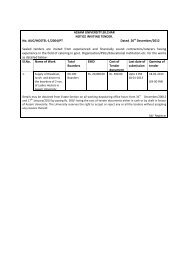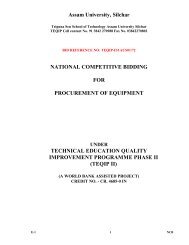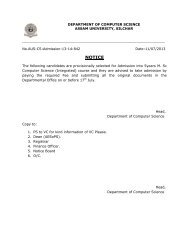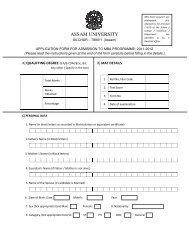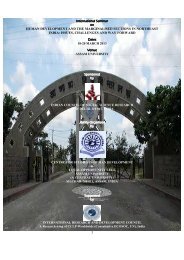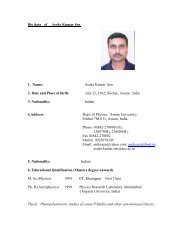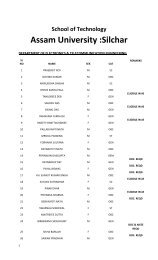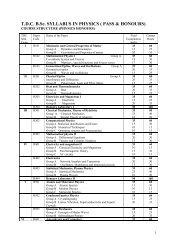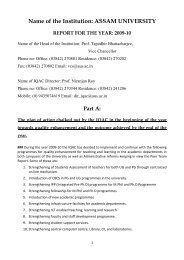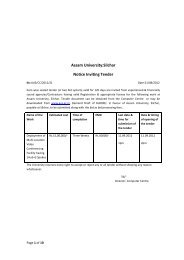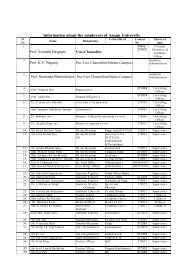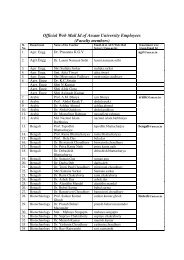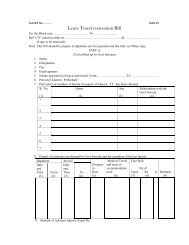Institutional Biosafety Committee(IBSC) - Assam University
Institutional Biosafety Committee(IBSC) - Assam University
Institutional Biosafety Committee(IBSC) - Assam University
Create successful ePaper yourself
Turn your PDF publications into a flip-book with our unique Google optimized e-Paper software.
2<br />
Concept of <strong>Biosafety</strong><br />
In India, GMOs and products thereof are regulated as per the “Rules for the manufacture,<br />
use/import/export and storage of hazardous microorganisms/ genetically engineered organisms or<br />
cells, 1989” (commonly referred as Rules, 1989) notified by the Ministry of Environment and<br />
Forests (MoEF), Government of India under the Environment (Protection) Act (1986). These rules<br />
are implemented by MoEF, the Department of Biotechnology (DBT), Ministry of Science and<br />
Technology and the State Governments through the six competent authorities notified under the<br />
Rules which are as follows:<br />
• Recombinant DNA Advisory <strong>Committee</strong> (RDAC)<br />
• <strong>Institutional</strong> <strong>Biosafety</strong> <strong>Committee</strong> (<strong>IBSC</strong>)<br />
• Review <strong>Committee</strong> on Genetic Manipulation (RCGM)<br />
• Genetic Engineering Appraisal <strong>Committee</strong> (GEAC)<br />
• State Biotechnology Coordination <strong>Committee</strong> (SBCC)<br />
• District Level <strong>Committee</strong> (DLC).<br />
DBT has taken several initiatives to strengthen the functioning of the <strong>IBSC</strong>s ( Box 1). Pursuant<br />
to issuing various guidelines in 1990 and 1998, DBT in association with Biotech Consortium India<br />
Limited (BCIL) organised a series of national consultations at six locations for the <strong>IBSC</strong> members<br />
and the DBT nominees with an objective to apprise them about their roles in greater depth and<br />
detail. A detailed background document was prepared and circulated in the meetings. The<br />
interaction between the faculty and <strong>IBSC</strong> members helped in clarifying the roles and<br />
responsibilities of <strong>IBSC</strong> members in general and the DBT nominees in particular.<br />
Initiatives by DBT for regulatory ry compliance by <strong>IBSC</strong>s
3<br />
Guidelines for <strong>IBSC</strong>s<br />
The following is the text of guidelines for <strong>IBSC</strong>s as adopted by Review <strong>Committee</strong> on Genetic<br />
Mainpulation (RCGM):<br />
1. Purpose/Objectives<br />
The purpose of these guidelines is to provide guidance to organisations that have <strong>Institutional</strong><br />
<strong>Biosafety</strong> <strong>Committee</strong>s (<strong>IBSC</strong>s) or intend to set up an <strong>IBSC</strong> in compliance with “Rules for the<br />
manufacture, use/import/export and storage of hazardous microorganisms/ genetically<br />
engineered organisms or cells, 1989” (hereinafter referred as Rules, 1989) notified by the Ministry<br />
of Environment and Forests (MoEF), Government of India under the Environment (Protection) Act,<br />
1986. As a statutory committee that operates from the premises of an organisation, <strong>IBSC</strong> is in a<br />
position to conduct onsite evaluation, assessment and monitoring of adherence to the biosafety<br />
guidelines with overall oversight of the regulatory process, at the institutional level. The decisions<br />
taken by the next higher committee i.e., Review <strong>Committee</strong> on Genetic Manipulation (RCGM), which<br />
operates from the Department of Biotechnology (DBT), Ministry of Science and Technology,<br />
Government of India are based on the applications submitted by the investigators with the approval<br />
of <strong>IBSC</strong>. Therefore,it is pertinent that <strong>IBSC</strong>s have expertise in evaluation, assessment and<br />
monitoring of projects and ensure compliance with the Rules, 1989, Recombinant DNA (rDNA)<br />
Safety Guidelines,1990 and other guidelines issued by DBT from time to time.
4<br />
2. Scope<br />
These guidelines describe the constitution, composition, role and functions of <strong>IBSC</strong>s. The guidelines<br />
provide information for compliance requirements by <strong>IBSC</strong>s and processes to be followed while<br />
dealing with genetically modified organisms (GMOs)/living modified organisms (LMOs) and rDNA<br />
materials in line with Rules, 1989 and guidelines issued by DBT from time to time.<br />
3. Terminology<br />
• <strong>Biosafety</strong> Officer: The <strong>Biosafety</strong> Officer is the designated officer appointed in case rDNA research<br />
involves biosafety level 3 or 4 containment facilities or large scale rDNA research.<br />
• Containment (adopted from rDNA safety guidelines, 1990): The term “containment” is used to<br />
describe safe methods for managing infectious agents and/or regulated GMOs/LMOs/rDNA<br />
material in the laboratory environment where they are being handled or maintained<br />
• DBT: Department of Biotechnology, Ministry of Science and Technology, Government of India<br />
• Genetic Engineering (as in Rules, 1989): The technique by which heritable material, which does<br />
not usually occur or will not occur naturally in the organism or cell concerned, generated outside<br />
the organism or the cell is inserted into said cell or organism. It shall also mean the formation of<br />
new combinations of genetic material by incorporation of a cell into a host cell, where they occur<br />
naturally (self cloning) as well as modification of an organism or in a cell by deletion and removal of<br />
parts of the heritable material.<br />
• GEAC: Genetic Engineering Appraisal <strong>Committee</strong><br />
• Head: The Head refers to the Head of an organisation involved in rDNA activities, e.g. Vice<br />
Chancellor of a university or other educational institute, Chief Executive Officer (CEO)/Managing<br />
Director usually of a body corporate, Director General/Director/Head of an Agency, Research<br />
Institution, Department, Division, Industrial Research and Development Unit or its equivalent<br />
• <strong>IBSC</strong>: The <strong>Institutional</strong> <strong>Biosafety</strong> <strong>Committee</strong> (<strong>IBSC</strong>) is a statutory committee of an organisation<br />
undertaking rDNA activities, constituted as per provisions of Rules,1989 and chaired by the Head of<br />
the organisation or his designate (a suitable senior officer).<br />
• Incident: This means unintended release, breach of containment, spill or occupational exposure to<br />
GMOs/LMOs/rDNA materials.<br />
• Principal Investigator: The Principal Investigator (PI) is involved in conducting modern<br />
biotechnology research in an organisation. The PI is accountable to the <strong>IBSC</strong> and must comply with<br />
the appropriate research guidelines and all applicable laws and guidelines related to biosafety.
5<br />
Recombinant DNA (as in rDNA safety guidelines, 1990): Recombinant deoxyribonucleic acid (rDNA)<br />
by definition involves in vitro introduction of different segments of DNA (one being the vector and<br />
the others normally unrelated DNA sequences) that are capable of replication in a host cell either<br />
autonomously or as an integral part of host’s genome and maintenance of their continued<br />
propagation. This will include all types of cell fusion, microinjection of DNA or RNA or parts of all of<br />
chromosomes, genetic engineering including self cloning and deletion as well as cell hybridization,<br />
transformation and other types of virus or pathogen introduction into unnatural host. The<br />
organisms involved may belong to these categories:<br />
i. Intergeneric organisms<br />
ii. Well defined organisms with non coding regulatory regions.<br />
iii. Biological agents whose source of DNA is a pathogen.<br />
iv. Organisms that are generally recognized as non-pathogenic and may imbibe<br />
the characteristics of a pathogen on genetic manipulation.<br />
• Regulatory Authority: RCGM is the Regulatory Authority functioning in DBT to whom <strong>IBSC</strong>s shall<br />
report and Genetic Engineering Appraisal <strong>Committee</strong> (GEAC) is the apex Regulatory Authority<br />
functioning in MoEF responsible for authorizing environmental release.<br />
• RCGM: Review <strong>Committee</strong> on Genetic Manipulation<br />
4. Constitution of <strong>IBSC</strong><br />
i. Any organisation, which undertakes research, shall establish an <strong>IBSC</strong> to ensure that all activities<br />
conducted comply with Rules 1989 and various guidelines issued by DBT from time to time.<br />
ii. The <strong>IBSC</strong> shall be registered with DBT.<br />
5. Tenure of <strong>IBSC</strong><br />
i. Each <strong>IBSC</strong> shall be registered for a period of three years.<br />
ii. The registration needs to be renewed after every three years.<br />
iii. The request for renewal must be submitted 60 days in advance before the expiry of the tenure of<br />
<strong>IBSC</strong>.<br />
6. Composition<br />
6.1 <strong>IBSC</strong> membership<br />
The <strong>IBSC</strong> shall have the following members:<br />
• Head of the organisation or his designate (a suitable senior officer) as the Chairperson
6<br />
• Three or more scientists engaged in rDNA work or molecular biology with atleast one outside<br />
expert in the relevant discipline.<br />
• A member with medical qualifications - <strong>Biosafety</strong> Officer (in case of work with pathogenic<br />
agents/large scale use).<br />
• A nominee of DBT.<br />
One of the in house scientists may be designated as Member Secretary. The <strong>IBSC</strong> may comprise as<br />
many member as the organisation consider necessary to enable proper examining the type of<br />
activities with GMOs/LMOs and rDNA materials being undertaken with the organisation. There is<br />
no upper limit to<br />
the membership of <strong>IBSC</strong>.<br />
6.2 <strong>IBSC</strong> Chairperson<br />
The Head of the organisation or his designate (suitable senior officer) shall chair the <strong>IBSC</strong>. The<br />
Chairperson should represent the organisztion and preferably have knowledge and experience in<br />
scientific research pertaining to rDNA technology and GMOs/LMOs.<br />
6.3 Appointment of <strong>IBSC</strong> Members<br />
<strong>IBSC</strong> members are appointed by the Head of the organisation, and will serve a 3 year term unless<br />
they are appointed to complete the term of any member who cannot serve <strong>IBSC</strong> any longer because<br />
of reasons like resignation, retirement, transfer, suspension etc. Members may be reappointed at<br />
the end of each 3 year term. There is no limit to the number of terms a member may serve as an<br />
<strong>IBSC</strong> member. Membership can be annually reviewed by the <strong>IBSC</strong> Chairperson and Head of the<br />
organisation and appropriately modified based<br />
upon participation.<br />
6.4 <strong>Biosafety</strong> Officer<br />
The organisation must appoint a <strong>Biosafety</strong> Officer, if research is conducted on organisms that<br />
require special containment conditions (<strong>Biosafety</strong> Level 3 or 4) or if large-scale rDNA research is<br />
conducted. This person is also a member of the <strong>IBSC</strong> and acts as a technical liaison between<br />
researchers and the <strong>IBSC</strong>. The <strong>Biosafety</strong> Officer should be adequately trained and be able to offer<br />
advice on<br />
specialized containment requirements.<br />
6.5 DBT Nominee<br />
Each <strong>IBSC</strong> has a nominee from DBT who oversees the activities to ensure that safety aspects are<br />
being fully adhered by the organisation. The DBT nominee serves as the link between DBT and the<br />
respective <strong>IBSC</strong>.
7<br />
6.6 Changes in <strong>IBSC</strong> Membership<br />
Any changes in <strong>IBSC</strong> membership/composition including the Chairperson will be notified by the<br />
<strong>IBSC</strong> Chairperson/Member Secretary to DBT within two weeks of the new<br />
appointment/discontinuation. Such notice should include a revised list of members, contact details<br />
and background information on each new member.<br />
6.7 Use of Experts/Consultants<br />
<strong>IBSC</strong> may use qualified experts/ consultants from within or outside organization for advice and<br />
information, as and when required. Participation of such external experts/consultants in meeting<br />
should be recorded in the minutes.<br />
7. Procedure of registration/renewal<br />
7.1 Registration of <strong>IBSC</strong><br />
Every organisation setting up an <strong>IBSC</strong> needs to identify the members as listed in section 6.1. The<br />
request has to be submitted to DBT in prescribed proforma along with overview of the organisation<br />
and brief bio-data of the proposed members including qualifications, affiliation and relevant<br />
experience. DBT then identifies and nominates an appropriate representative as a DBT nominee<br />
and communicates the same to <strong>IBSC</strong> Chairperson. With this the <strong>IBSC</strong> of the organisation gets<br />
registered.<br />
7.2 Renewal of <strong>IBSC</strong><br />
The procedure for renewal of an <strong>IBSC</strong> is similar to registration process. The format of renewal has<br />
been prescribed by DBT and the same should be used for renewal of <strong>IBSC</strong> registration. The<br />
requirements with respect to list and<br />
background of proposed members etc. are the same as for registration.<br />
8. Role of <strong>IBSC</strong> in approval<br />
The role of <strong>IBSC</strong> in research, large-scale experiments/ production/field release and import and<br />
shipment shall be as under:<br />
8.1 Research activities related to rDNA technology: <strong>IBSC</strong> has to review all recombinant research<br />
carried out by an organisation depending upon the category of experiments, <strong>IBSC</strong> can simply note<br />
the information provided by PI, give permission before start of the experiments or forward it to<br />
RCGM for approval as per the Recombinant DNA Safety Guidelines, 1990 of DBT.<br />
• Category I experiments involving self cloning, using strains and also inter species cloning<br />
belonging to organism in the same exchanger group etc. are exempt for the purpose of intimation<br />
and approval.
8<br />
• Category II experiments falling under containment levels II, III and IV, large scale use of<br />
recombinants made of self cloning in systems belonging to exempt category etc. require prior<br />
intimation to <strong>IBSC</strong>.<br />
• Category III experiments involving toxin gene cloning, cloning of genes for vaccine production, use<br />
of infectious animals and plant viruses, self fusion experiments, field testing and release of GMOs<br />
etc. require review and approval of <strong>IBSC</strong> before commencement. Different levels of containment<br />
have been prescribed for different categories of rDNA experiments in the Guidelines. <strong>IBSC</strong> should<br />
allow genetic engineering activity on classified organisms only at places where such work can be<br />
performed as per Guidelines and containment facilities. Provision of suitable safe storage facility of<br />
donor, vectors, recipients and other materials involved in experimental work should be made and<br />
may be subject to inspection for accountability on biosafety.<br />
8.2 Research activities related to transgenic plants: In case of research activities related to<br />
transgenic plants, <strong>IBSC</strong>s shall follow “Revised Guidelines for Research in Transgenic Plant, 1998” by<br />
DBT (http://dbtbiosafety.nic.in). Routine recombinant DNA experiments fall in Category I and need<br />
only intimation to the <strong>IBSC</strong> in the prescribed proforma. Category II include lab and greenhouse/<br />
nethouse experiments in contained environment where defined DNA fragments that are non<br />
pathogenic to human and animals are used for genetic transformation of plants. Permission for<br />
performing Category II experiments is provided by <strong>IBSC</strong> but the decision of the <strong>IBSC</strong> needs to be<br />
intimated to the RCGM before execution of the experiment and RCGM would put this information on<br />
record. Category III pertains to high risk experiments where the escape of transgenic traits into the<br />
open environment could cause significant alterations in the biosphere, the ecosystem, the plants<br />
and animals by dispersing new genetic traits, the effects of which cannot be judged precisely. All<br />
experiments conducted in greenhouse and confined field conditions not belonging to the above<br />
Category II types, would fall under Category III risks. Such experiments could be conducted only<br />
after clearance from RCGM and notified by DBT.<br />
8.3 Large scale trials and production: In cases for conduct of field trials and large scale production,<br />
<strong>IBSC</strong> has to verify the information being forwarded to RCGM and GEAC in terms of physical<br />
containment conditions, categorization in terms of risk assessment etc., as further reviews by these<br />
regulatory committees depends on the review of the <strong>IBSC</strong> on the submissions made. <strong>IBSC</strong> has to<br />
recommend emergency plan in case of large-scale operations, as and when required, which would<br />
be then approved by competent authorities i.e. RCGM and GEAC. Emergency plan shall include<br />
methods and procedures for handling large volumes of cultures and organisms for production,<br />
transport, storage or disposal etc.
9<br />
8.4 Import and transfer/shipment<br />
• The interstate transfer/shipment of indigenous etiological agents, diagnostic specimens and<br />
biological products need clearance of <strong>IBSC</strong> and is subject to appropriate packaging, labeling and<br />
shipping requirements.<br />
• The import permits of regulated materials for research and specifying conditions under which the<br />
agent or vector is shipped, handled and use are issued by RCGM while large scale imports regulated<br />
material for environmental and industrial use are regulated by GEAC.<br />
In case of plants, the import is routed through the Director, National Bureau of Plant Genetic<br />
Resources (NBPGR) on the basis of the import permit issued by the RCGM Secretariat, based on<br />
recommendations of the RCGM. However, all these proposals need to be submitted by the PIs<br />
through their <strong>IBSC</strong>s.<br />
9. Functions<br />
9.1 <strong>IBSC</strong><br />
The responsibilities of the <strong>IBSC</strong> include, but are not limited to the following:<br />
• Review and clearance of project proposals falling under restricted category and as per guidelines<br />
issued by DBT from time to time and elaborated above in Section 8.<br />
• Tailoring biosafety programme to the level of risk assessment.<br />
• Assess and monitor the research facilities, procedures and experts involved in GMOs/LMOs and<br />
rDNA research.<br />
• Inform the Principal Investigator about <strong>IBSC</strong> review, approval or rejection of their projects<br />
• Information of all relevant activities involving the use of GMOs/LMOs and rDNA research to the<br />
RCGM.<br />
• Ensure that the information provided in the application form is correct and complete.<br />
• Provide guidance to Principal Investigator on the issues related to <strong>Biosafety</strong> while using<br />
GMOs/LMOs and rDNA research including safety of all the members associated with the research<br />
activity.<br />
• Assess field experiments to ensure that the proposed risk assessment, risk management and<br />
emergency plan are sufficient.<br />
• Review the emergency plan proposed by the Principal Investigator for responding to an accidental<br />
release of a GMO and those adopted to meet any exigencies. Copies of site emergency plan to be<br />
submitted to RCGM,
10<br />
GEAC, State Biotechnology Coordination <strong>Committee</strong> (SBCC) or District Level <strong>Committee</strong> (DLC) as<br />
the case may be, as per Rules, 1989.<br />
• Review and report to the Head of the organisation and to Member Secretary, RCGM of any noncompliance<br />
of guidelines / problems.<br />
In addition, the Chairperson, Member Secretary, <strong>Biosafety</strong> Officer and DBT nominee of <strong>IBSC</strong> have<br />
specific functions. Further the Principal Investigator(s) of the project(s) have significant role to<br />
play in complying with he regulatory framework. The responsibilities of each of above are<br />
elaborated below:<br />
9.2 Chairperson<br />
• The Chairperson should preside over the <strong>IBSC</strong> meetings and serve as the contact with all<br />
regulatory agencies to help liaise between the organization and the <strong>IBSC</strong>. The Chairperson of <strong>IBSC</strong><br />
may designate a member of the<br />
<strong>IBSC</strong> to serve as Acting Chair in his/her long term absence. • Have awareness of all requirements<br />
regarding compliance with the Rules, 1989 and any related regulations regarding<br />
GMOs/LMOs/rDNA materials and ensure that the biosafety guidelines are followed in his<br />
organisation. • Ensure that the facilities at the organisation are sufficient to meet the containment<br />
levels stipulated for rDNA products and processes, as per the guidelines.<br />
• Make sure that regular meetings of <strong>IBSC</strong> are held to review recombinant research projects in the<br />
organisation and open discussion takes place amongst the members in the meetings and the views<br />
of external members as well DBT nominee are recorded sincerely.<br />
• Provide leadership and support that laboratory personnel receive appropriate training prior to<br />
the initiation of research projects (i.e. experimental procedures).<br />
9.3 Member Secretary<br />
• The Member Secretary shall be responsible for all reporting and communication with respect to<br />
functioning of <strong>IBSC</strong> in an organization<br />
• Maintain documents, agenda minutes of meetings and other related papers for proper record<br />
keeping<br />
• Organising meetings and provide technical advice to Principal Investigator about safety procedure<br />
and containment facility.<br />
9.4 <strong>Biosafety</strong> Officer<br />
• Act as a focal point for compliance with rDNA safety guidelines, good lab practices, biological<br />
containment etc
11<br />
Ensure that measures are in place to prevent the accidental escape of regulated GMOs/LMOs and<br />
rDNA materials.<br />
• Undertake periodic laboratory inspections. • Assist Investigator in developing emergency plans<br />
for containment and clean up accidental spills; investigates and reviews recombinant DNA lab<br />
Accident<br />
• A report from the officer may form part of the <strong>IBSC</strong>s annual report.<br />
9.5 Principal Investigator<br />
All recombinant research projects carried out by an organisation involving the use of GMOs/LMOs<br />
or rDNA materials should have a Principal Investigator (PI). It is the duty of the PI to apprise the<br />
<strong>IBSC</strong> about the nature of the experiments being carried out. Depending upon the risk category, the<br />
PI has to inform the <strong>IBSC</strong>, seek permission of <strong>IBSC</strong> before starting the experiments or seek<br />
permission of the RCGM through its <strong>IBSC</strong>. Based on the nature of the GMOs/LMOs and rDNA<br />
materials, the PI determines the proper containment level for the project and, in accordance with<br />
the guidelines, develops the necessary experimental protocols. This nformation is then submitted to<br />
<strong>IBSC</strong> for review. The responsibilities of PI are summarized below:<br />
• to make an initial determination of the required levels of physical and biological containment in<br />
accordance with the stipulated guidelines.<br />
• to submit the initial research protocol and any subsequent changes (such as changes in the source<br />
of DNA or host vector system) to the <strong>IBSC</strong> for review and approval.<br />
• to ensure that no work is initiated until the research project has been approved by the <strong>IBSC</strong> and<br />
has met all requirements of DBT guidelines.<br />
• to communicate with <strong>IBSC</strong> throughout the conduct of the project.<br />
• to ensure safe conduct of the rDNA experiments in his laboratory.<br />
• to make available the protocols that describe the potential biohazards and the precautions to be<br />
taken to all laboratory staff.<br />
• to instruct laboratory staff about the practices and techniques required to ensure safety, and the<br />
procedures for dealing with accidents including the reasons and provisions for any precautionary<br />
medical practices advised or<br />
requested (e.g. vaccinations or serum collection).<br />
• to supervise the performance of the laboratory staff to ensure that the required safety practices<br />
and techniques are employed.<br />
• to undertake corrective measures promptly for any work errors and conditions that may result in<br />
the release of recombinant DNA materials.
12<br />
9.6 DBT nominee<br />
The duty of the DBT nominee is to ensure that:<br />
• The <strong>IBSC</strong> has been constituted as per the norms.<br />
• The stipulated rDNA Safety Guidelines are strictly followed in the organisation/institution.<br />
• The <strong>IBSC</strong> meets regularly, at least twice in a year to review the ongoing activities and provides<br />
annual reports to RCGM in the prescribed proforma.<br />
• All the activities are within the purview of the guidelines and in the knowledge of RCGM.<br />
• The DBT nominee is also expected to guide the <strong>IBSC</strong> on biosafety issues.<br />
10. <strong>IBSC</strong> meetings<br />
10.1 Regular meetings<br />
The <strong>IBSC</strong> shall meet as required. However each <strong>IBSC</strong> has to meet at least twice in a year to review<br />
and approve the rDNA projects in an organisation. It is important that the Chairperson and Member<br />
Secretary ensure that regular meetings take place. More than two meetings may be held as per<br />
requirement of the projects. The <strong>IBSC</strong> members are expected to look into the following aspects<br />
during the meetings:<br />
• Action taken on the decisions of earlier <strong>IBSC</strong> meetings.<br />
• Assessment of work elements and approval as per risk category of organism involved.<br />
• Evaluation of projects and direction for submission to appropriate agencies for statutory<br />
approvals.<br />
Inspection of containment facilities, unit process areas, greenhouses etc. and preparation of reports<br />
for regulatory agencies.<br />
• Review the medical reports of employees<br />
• Examining and recommending procedures and other approval requirements.<br />
10.2 Emergency meetings<br />
The Chairperson may call an emergency meeting of the <strong>IBSC</strong> to address any urgent issues such as<br />
non-compliance or unexpected events involving GMOs/ LMOs/ rDNA materials in an organisation.<br />
10.3 Documents to be reviewed<br />
Prior to the regular meeting, each member should be sent a copy of the documents to be reviewed<br />
at the meeting, in addition to other information to be discussed. The prescribed formats for<br />
information on projects to the <strong>IBSC</strong> and RCGM should be used appropriately.<br />
10.4 Attendance and Quorum
13<br />
Attendance of members at <strong>IBSC</strong> meetings is mandatory. Members who are unable to attend the<br />
meeting should inform the Chairperson, <strong>IBSC</strong> and provide a written summary of their review and<br />
any comments to the<br />
<strong>IBSC</strong>. It is mandatory to provide the duly signed attendance sheet as part of <strong>IBSC</strong> minutes, while<br />
submitting the minutes of <strong>IBSC</strong> meeting to the Member Secretary, RCGM. At least 50% of the <strong>IBSC</strong><br />
members along with DBT nominee must be present to conduct the meeting. The final approval or<br />
disapproval of non-exempt projects of GMOs/LMOs/rDNA materials requires a majority vote by<br />
<strong>IBSC</strong> members and DBT nominee. If a quorum is lost at any time during the meeting, the meeting<br />
should be adjourned and no further action should be taken by the <strong>IBSC</strong> until a quorum is reestablished<br />
or a new meeting is appropriately convened.<br />
10.5 Minutes of <strong>IBSC</strong> meetings<br />
Minutes of <strong>IBSC</strong> meetings should include the following information:<br />
i. Attendance of members and invitees, if any. <strong>IBSC</strong>’s review and decisions on all<br />
applications considered in the meeting including modifications to project proposals,if<br />
any.<br />
ii. Remarks on suitability of facilities with respect to containment requirements after<br />
inspection of GMOs/LMOs/rDNA facilities and suggestions, if any.<br />
iii. Signatures of the Chairperson and DBT nominee is compulsory otherwise minutes will<br />
be treated as an invalid.<br />
iv. The minutes should clearly indicate about discussions and decisions taken during the<br />
meeting.<br />
The intent of the minutes will be to provide sufficient detail about discussions on these matters and<br />
to document the <strong>IBSC</strong>’s rationale for particular decisions taken.<br />
11. Conflict of interest<br />
<strong>IBSC</strong> members who have a conflict of interest in a project should not be present during the <strong>IBSC</strong>’s<br />
initial or project extension review deliberations on the project. This might be their own proposal, or<br />
a proposal in which they are coinvestigators, or in which they or a family member has a financial<br />
interest. Minutes should record the information on such members who have declared a conflict of<br />
interest.<br />
12. Confidentiality<br />
All members including DBT nominee and external experts are expected to maintain confidentially<br />
of the proposals and other related information made available to them for review, reference or
14<br />
discussion and not divulge any confidential or Intellectual Property (IP) or commercial business<br />
information (CBI) of an applicant/organisation/institute acquired as a result of review of such<br />
proposals and subsequent discussions. <strong>IBSC</strong> members are also expected to respect the confidential<br />
nature of the opinions expressed by other <strong>IBSC</strong> members or invited experts during discussions in<br />
the meetings or provided in written form and not divulge to any person, press or media. If desired,<br />
<strong>IBSC</strong>s can sign a confidentiality agreement with the members including DBT nominee and/or<br />
external experts so as to ensure confidentiality of applications, issues and other matters placed<br />
before an <strong>IBSC</strong>.<br />
Persons responsible for compliance<br />
The responsibility for biosafety at an organisation rests with the Head of the organisation and PI,<br />
who obtains, possesses or uses GMOs/LMOs/rDNA materials. <strong>IBSC</strong> provides guidance to ensure<br />
compliance. Any possession and/ or use of these materials at the organisation must be conducted<br />
with appropriatesafeguards against environmental release.<br />
Head of the Organisation<br />
The head of the organisation is responsible for compliance with Rules, 1989 and other related<br />
regulations regarding rDNA research. The head maintains ultimate responsibility for the safe<br />
conduct of activities involving GMOs/LMOs/rDNA research.<br />
Principal Investigator (PI)<br />
The PI is required to comply with the appropriate research guidelines and all applicable laws<br />
related to biosafety and is accountable to the Head and <strong>IBSC</strong> . Laboratory Personnel (Technician,<br />
Technologist, Student, Post-doctorate) Laboratory personnel must:<br />
i. Follow all safety guidelines and establish good laboratory practices. They must work within the<br />
assigned biological safety containment level and use personal protective equipment as<br />
recommended by the PI.<br />
ii. Immediately notify the PI or BSO of any health condition that may be due to their work in the<br />
laboratory or any health condition that may be compromised prior to the initiation of a research<br />
project (i.e. pregnancy, immunosuppression).<br />
iii. Follow all practices and procedures as provided by the PI and BSO, and ensure strict compliance<br />
with all required biosafety regulations and guidelines. Report problems, procedural mistakes, spills,<br />
etc. to the PI, and if necessary to the BSO, as soon as they occur. Report to the PI, BSO or <strong>IBSC</strong> on<br />
non-compliance of biosafety guidelines or policies.
15<br />
Addressing noncompliance<br />
Noncompliance by Principal Investigator (PI)/ Organisation<br />
The <strong>IBSC</strong> can address non-compliance to the Rules, 1989 or to the organisation’s policies and<br />
procedures and any other relevant legal requirements. Non-compliance can result in the <strong>IBSC</strong><br />
taking one or more of the following actions:<br />
i. Suspension of the use of GMOs/LMOs/rDNA materials.<br />
ii. Cessation of the approval for use of the GMOs/LMOs/rDNA materials.<br />
iii. Confiscation and/or destruction of the GMOs/LMOs/rDNA materials.<br />
iv. Any other action necessary to protect the public and/or the organisation, including suspending<br />
the relevant research activity.<br />
v. Reporting to the RCGM.<br />
Noncompliance by <strong>IBSC</strong>s<br />
The registration of an <strong>IBSC</strong> can be cancelled by DBT in case <strong>IBSC</strong> does not comply with stipulated<br />
guidelines, including reporting requirements. If annual report of an <strong>IBSC</strong> is not received for two<br />
consecutive years, the registration will automatically laps and the organisation shall have to reintiate<br />
the process of registration of its <strong>IBSC</strong>
16<br />
Check List for <strong>IBSC</strong>s
19<br />
In the year 2009, the <strong>Institutional</strong> <strong>Biosafety</strong> <strong>Committee</strong> was initiated by Prof. Sanjib K. Panda,<br />
Department of Life Science and Bioinformatics, <strong>Assam</strong> <strong>University</strong>, Silchar and constituted accordingly<br />
with the approvals of university and DBT. Subsequently three meeting were held, whose minutes<br />
upon approval have been circulated to DBT and user departments of the university. Below are the<br />
minutes of the <strong>IBSC</strong> meetings along with the Proforma of <strong>IBSC</strong> Application and Certificate.
20<br />
Minutes of the 3 <strong>IBSC</strong> meeting held on 20 March, 2012.<br />
Members Present:<br />
Dr. Sanjib Kumar Panda<br />
(Member Secretary, <strong>IBSC</strong>, AUS)<br />
Dr. Lingaraj Sahoo<br />
(DBT Nominee, <strong>IBSC</strong>, AUS)<br />
Dr. Ravi Rajwanshi<br />
(Member, <strong>IBSC</strong>, AUS)<br />
Dr. Himanshu K Prasad<br />
(Special Invitee)<br />
Dr. Shuvasish Choudhury<br />
(Special Invitee)<br />
Dr. Shubhadeep RoyChoudhury<br />
(Special Invitee)<br />
Dr. (Mrs.) Satabisha RoyChoudhury (Representative of Medical Officer)<br />
1. Dr. S. K. Panda (Member Secretary, <strong>IBSC</strong>) appraised the members about the constitution of the <strong>IBSC</strong><br />
in <strong>Assam</strong> <strong>University</strong>, Silchar. He presented the 2 nd <strong>IBSC</strong>’s minutes of meeting held on 11 th Aug 2011.<br />
He welcomed all the special invitees in the meeting.<br />
2. Dr. Lingaraj Sahoo (DBT Nominee, <strong>IBSC</strong>) briefed all the members regarding categorization and safety<br />
measures to be taken care while carrying out the scientific research involving pathogenic<br />
strains/organism or GMO according to DBT guidelines.
21<br />
3. The committee circulated the DBT recommended performa to all the members present in the meeting<br />
for their information as well as the researchers in the concerned departments in AUS needing <strong>IBSC</strong><br />
certificate.<br />
4. The committee emphasized on the proper disposal of waste having potential bio-hazardous<br />
properties for the surrounding environment ( (viz.<br />
EtBr gels, GMO’s, pathogenic/non-pathogenic<br />
microbial cultures etc.) by the concerned users in the institute/university.<br />
5. The committee urged for taking the prior permission from <strong>IBSC</strong> by the concerned person if any<br />
GMO/pathogenic strain has to be exchanged with other university/institute for scientific research.<br />
r<br />
6. The committee appreciated the inclusion of course/topics related to the Bio-safety in the syllabus of<br />
M.Sc./Ph.D. students of the School of Life Sciences, <strong>Assam</strong> <strong>University</strong>, Silchar.<br />
7. The committee proposed to conduct a workshop on Bio-safety related issues for the awareness of<br />
students and scientific research community in North-east India.<br />
8. The committee reminded the Medical officer to perform proper medical check up of any member<br />
accidentally exposed to the biohazard who is affiliated to the institute/university.<br />
i<br />
9. The committee recommended including Central Instrumentation Laboratory and Dept. of<br />
Pharmaceutical Sciences, <strong>Assam</strong> <strong>University</strong>, Silchar as the user departments and all the necessary<br />
information related to <strong>IBSC</strong> issues be circulated to them.<br />
10. The committee recommended including Dr. Satabisha RoyChoudhury as invited member in the<br />
forthcoming <strong>IBSC</strong> meeting.<br />
11. The committee recommended the university authorities to circulate the DBT’s “Recombinant DNA<br />
Safety Guidelines” to all the user departments and affiliated colleges of <strong>Assam</strong> <strong>University</strong> if not done<br />
so far.<br />
12. The committee recommended the concerned university authorities to upload all the minutes of<br />
meeting(s) of <strong>IBSC</strong> held till date and going to be held in future on university website for information<br />
of all the user members affiliated to <strong>Assam</strong> <strong>University</strong>, Silchar.<br />
13. The meeting ended with vote of thanks by the Member Secretary, <strong>IBSC</strong>, <strong>Assam</strong> <strong>University</strong>, Silchar.<br />
Member Secretary<br />
<strong>IBSC</strong>, AUS<br />
Chairman<br />
<strong>IBSC</strong>,AUS
22<br />
Minutes of the <strong>Institutional</strong> <strong>Biosafety</strong> <strong>Committee</strong> <strong>Assam</strong> <strong>University</strong> (<strong>IBSC</strong> AU) meeting held on 11 th<br />
Aug 2011<br />
1. Dr. S.K. Panda, Member Secretary, <strong>IBSC</strong> AU briefed all the members present in the meeting<br />
about the constitution of <strong>IBSC</strong> in <strong>Assam</strong> <strong>University</strong>, Silchar.<br />
2. Dr. Lingaraj Sahoo, DBT Nominee, <strong>IBSC</strong>) briefed all the members present regarding some<br />
important issues to be taken care off for performing Recombinant DNA Technology (RDT)<br />
related research work in the university.<br />
3. The <strong>IBSC</strong> AU decided that the Chief Medical Officer of <strong>Assam</strong> <strong>University</strong> be included as a<br />
member of <strong>IBSC</strong> AU in place of Dr. S. S. Dhar of Medical College so as to keep a periodical<br />
health check up of personnel involved in the recombinant DNA work in the university, and<br />
the information be informed to DBT for ratification.<br />
4. The <strong>IBSC</strong> AU decided to advise the academic council of AU to include course/topics related<br />
to the Bio-safety in the syllabus of graduate and post graduate students of the <strong>Assam</strong><br />
<strong>University</strong> as well as its affiliated colleges.<br />
5. <strong>IBSC</strong> AU decided to circulate information to all the Principal Investigators of projects as well<br />
as faculties intending to perform recombinant DNA related experiments so that the<br />
investigators inform the <strong>IBSC</strong> AU about the risk involved in their proposed work in the<br />
appropriate format given in the DBT website link (http://dbtbiosafety.nic.in/) for<br />
necessary approval.
23<br />
6. <strong>IBSC</strong> AU recommended all the PI’s of the projects to take prior permission to work on<br />
Recombinant DNA Technology/ pathogenic strains etc. and if not done so, necessary action<br />
will be taken as per RCGM guidelines.<br />
7. <strong>IBSC</strong> AU instructed all the departments carrying out recombinant DNA related experiments<br />
to follow proper procedure for safe disposal of waste generated from recombinant DNA<br />
related experiments.<br />
8. <strong>IBSC</strong> AU recommended the university authorities to circulate the DBT’s “Recombinant DNA<br />
Safety Guidelines” to all the departments and affiliated colleges of <strong>Assam</strong> <strong>University</strong>.<br />
9. The Member Secretary, <strong>IBSC</strong> AU will circulate the notice to all the user departments before<br />
next meeting to submit a report in a DBT format to <strong>IBSC</strong> committee on their<br />
ongoing/upcoming projects/experiments involving Recombinant DNA Technology/<br />
pathogenic strains etc. related work for evaluation/record.
24<br />
Minutes of <strong>Institutional</strong> <strong>Biosafety</strong> meeting held at <strong>Committee</strong> Room, <strong>Assam</strong> <strong>University</strong>, Silchar on<br />
01.05.2009.<br />
Members present:<br />
1) Prof. Tapodhir Bhattacharjee, V.C., AUS Chairman<br />
2) Dr. Sanjib Kumar Panda Secretary, <strong>IBSC</strong>, AUS<br />
3) Prof. G.D. Sharma, PVC, AUS Member<br />
4) Dr. Bipob Bose, IITG DBT Nominee<br />
5) Dr. B.K. Tiwary Member<br />
01. Secretary, <strong>IBSC</strong> will inform the concerned departments that <strong>IBSC</strong> has been constituted and its<br />
first meeting has been held on 01.05.2009.<br />
02. Secretary, <strong>IBSC</strong> will also inform the concerned department to go through, the DBT guideline on<br />
biosafety and reouting DNA works and to follow the rollover rules and to inform <strong>IBSC</strong> whenever<br />
required.<br />
03. If required, Chairman <strong>IBSC</strong> can give approval for a particular research project as per the<br />
guidelines without holding the <strong>IBSC</strong> meeting. <strong>IBSC</strong> should be formally informed as per such<br />
decision and those approval should be notified to Annual <strong>IBSC</strong> meeting.<br />
Dr.S.K.Panda<br />
Secretary,<br />
<strong>IBSC</strong>, <strong>Assam</strong> <strong>University</strong>, Silchar
25<br />
ANNEXURE – III<br />
INFORMATION TO <strong>IBSC</strong>/ RCGM TO CARRY OUT RESEARCH FOR DEVELOPMENT OF TRANSGENIC<br />
PLANTS<br />
Application for clearance by <strong>IBSC</strong>/ RCGM to carry out research/experimental trials involving<br />
transgenic plants in green house and in contained open fields.<br />
1. Name of the Applicant:<br />
Designation:<br />
(a) Address (Registered Office)<br />
(b) Address (Research Station)<br />
2. Application for: Prior intimation to <strong>IBSC</strong> to carry out research involving ------<br />
2.1 Purpose:<br />
2.2 New Proposal:<br />
2.3 Ongoing Project:<br />
If yes, No. & Date of LOI issued:<br />
No. & Date of Permit issued:<br />
2.4 If yes, briefly state the purpose for which permission was granted.<br />
2.5 Category of experiments as per the Guidelines of DBT: Category II<br />
3. Objectives of the proposal:<br />
Main objectives of the proposed project are:<br />
. Description of the GMOs employed in the research proposal (in scientific terms; for new<br />
application only)<br />
4.1 Description of GMOs<br />
Description of the host organism:<br />
Taxonomy of the recipient organism:<br />
Kingdom: Plantae<br />
Phylum: Eudicots<br />
Class: Rosids<br />
Order: Brassicales<br />
Family: Brassicaceae<br />
Genus: Arabidopsis<br />
Species: thaliana<br />
Description of the recipient organism:
26<br />
4.2 Description of the target gene(s):<br />
4.3 Number of copies of the genes incorporated:<br />
4.4 Description of the target product(s):<br />
5. Details on:<br />
5.1 Source of nucleic acid(s):<br />
5.2 Nucleic acid sequence (Please enclose the nucleic acid sequence map of the target gene):<br />
5.3 Vector(s) (Please enclose the map of the vector gene):<br />
5.4 Host(s) that carrying the vector(s)/ target gene(s):<br />
5.5 Manipulative procedures:<br />
5.6 Anticipated functions of Product(s):<br />
6. Summary of the proposed work plan utilizing GMOs (please check it from the following areas and<br />
provide the details of work plan).<br />
6.1 Basic transformation and laboratory work to assess the expression of the target gene:<br />
6.2 Standardization of fermentation procedures below 20 It. capacity (if applicable)<br />
6.3 Assessment of toxicity and allergenicity of the product (if yes, please provide the following<br />
information) Not known<br />
i) Production/ fermentation procedures adopted<br />
ii) Purification procedures adopted; state briefly the processing chemicals used in the purification<br />
steps.<br />
iii) Physico-chemical characterization of the product; please provide limits of residues with there<br />
characterization/ identification.<br />
iv) Biochemical/immunological characterization of the product<br />
v) Information on Five batches production data<br />
vi) Toxicity and Allergenicity protocols and the address of the lab where these studies are proposed<br />
to be conducted:<br />
vii) <strong>Institutional</strong> Animal Ethics <strong>Committee</strong>'s Approval:<br />
6.4 Acceptability criteria of the bulk and the formulated material wherever ready for animal<br />
experiments.<br />
7. Site/ Location of the research work:<br />
8. Proposed containment facility (Please indicate the level of containment proposed):<br />
i. Good laboratory practice<br />
ii. Safety equipment (Primary containment)<br />
iii. Facility design (Secondary containment):<br />
iv. The donor and recipient organisms, vectors, recombinant constructs, control untransformed<br />
seeds and transgenic seeds will be safely stored in deep freezer and refrigerator respectively, and<br />
the stored facility will be made available to inspection by <strong>IBSC</strong> members.<br />
9. Decontamination and disposal mechanisms<br />
Decontamination: Disposal:<br />
10. Risk management (Emergency plan)
27<br />
11. Any other relevant information: Nil<br />
12. Declaration:<br />
I declare that the information provided in the above format is correct and accurate to the best of my<br />
knowledge. The "Safety Guidelines" brought out by the Department of Biotechnology, Ministry of<br />
Science & Technology, Govt. of India will be and is being strictly followed. In case any untoward<br />
incident occurs, the Chairman of the msc and the Member-Secretary of the RCGM will be informed<br />
immediately.<br />
Date:<br />
Signature of the Applicant<br />
Forwarded: The proposal set out above has been considered by the "<strong>Institutional</strong> <strong>Biosafety</strong><br />
<strong>Committee</strong>" on ____________________ and is forwarded to RCGM for further necessary action.<br />
Date:<br />
Signature of the Chairman, <strong>IBSC</strong><br />
(Note: Please submits 20 copies of the application to the Department of Biotechnology for placing<br />
the same in the meeting of RCGM)<br />
Annexure I: Map of the vectors
28<br />
INSTITUTIONAL BIOSAFETY COMMITTEE<br />
<strong>Assam</strong> <strong>University</strong>, Silchar<br />
Silchar-788011, <strong>Assam</strong>, India; Ph: 91-3842-270801; Fax: 91-3842-270802<br />
Certificate of Approval or Clearance<br />
Reference No. : <strong>IBSC</strong>/2012/01<br />
Dated:<br />
This is to certify that the project entitled “ --------” proposed by Dr./ Prof ------ for approval/clearance<br />
from <strong>IBSC</strong> AUS has been approved by the committee on its meeting held on ____________<br />
for<br />
conducting experiments as they fall under category _______ as declared by PI.<br />
(Signature of Member Secretary)<br />
<strong>IBSC</strong> AUS<br />
Dated:<br />
(Signature of Chairman)<br />
<strong>IBSC</strong> AUS<br />
Dated:



